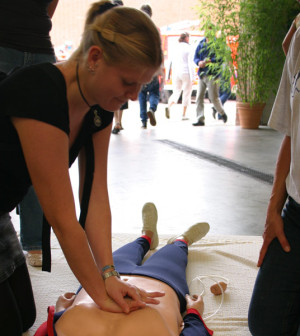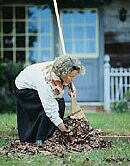- See What Saffron Can Do for Sleep and Heart Health
- 6 Common Mistakes to Avoid Before Your Physical
- Can Sweating Really Help You Beat a Cold?
- Strengthening Your Relationship: Practical Strategies
- Skip Storing This Everyday Product in the Fridge Door
- Green Tea + B3 Pairing May Boost Brain Health
- Navigating Your Midlife Crisis: Embracing New Possibilities
- City Raccoons Showing Signs of Domestication
- Mapping the Exposome: Science Broadens Focus to Environmental Disease Triggers
- One Week Less on Social Media Linked to Better Mental Health
Gardening, Housework May Help Boost Your Heart Health


TUESDAY, Oct. 29Activities such as gardening, do-it-yourself projects and housework may be as good as formal exercise when it comes to reducing the risk for heart attack and stroke, Swedish researchers say.
For people 60 and older, just keeping busy with daily activities can reduce the risk of cardiovascular problems by nearly 30 percent and even prolong life, they added.
Being on your feet and active cuts the time spent sitting around, pointed out lead researcher Elin Ekblom-Bak, of the Swedish School of Sport and Health Sciences and the Karolinska Institute, in Stockholm.
“Sitting is mainly replacing time you spend in daily activity and vice versa,” Ekblom-Bak said. A recent study found long periods of sitting actually increased the risk for diabetes, cardiovascular disease and death, she noted.
“The results of this study showed that activities of daily life are as important as regular intentional exercise for older adults for cardiovascular health and longevity,” she said.
But that doesn’t mean formal exercise isn’t important. “We saw that those who exercised regularly and that also had a daily physically active life had the lowest risk of all,” Ekblom-Bak explained.
The time people spend exercising, however, is only a small part of the day, which leaves a lot of time for daily activities or sitting, she added.
For the new study, researchers collected data on more than 3,800 men and women in Sweden who were born in 1937 and 1938. Participants were asked about their lifestyle, which included information on their diet, whether they smoked or drank alcohol, and how physically active they were.
The participants were also asked how often they took part in activities, such as gardening, do-it-yourself projects, car maintenance and blackberry picking over the past year. They were also asked about any exercise they did.
To see how heart-healthy they were, the researchers examined the participants and took blood samples to assess levels of fat and sugar. They also checked for high levels of blood-clotting factor, which is linked to a raised heart attack and stroke risk.
During more than 12 years of follow-up, 476 of the participants died from or experienced a first heart attack or stroke, and 383 died from other various causes.
People whose daily activities kept them moving reduced their risk of a heart attack or stroke by 27 percent and the risk of dying from any cause by 30 percent, compared to people who spent the least amount of time on their feet.
“Promoting daily life activities is as important as recommending regular exercise for older adults for cardiovascular health and longevity,” Ekblom-Bak said.
“This is particularly important for older adults as they tend to spend a greater portion of their active day performing non-exercise physical activity, as they often find it difficult to achieve recommended exercise intensity levels,” she said.
The report was published online Oct. 28 in the British Journal of Sports Medicine.
Traditional notions of retirement often don’t support continued physical activity at this stage of life, a U.S. expert said.
“It is almost expected that as we age, we move less,” said Samantha Heller, a senior clinical nutritionist and exercise physiologist at NYU Langone Medical Center, in New York City.
“Retirement, a patient told me, is for sitting around, resting and watching TV,” she said. “Unfortunately, sedentary lifestyles now range across all ages with the same unhealthy results: increased risk for diseases such as cardiovascular disease, metabolic syndrome and certain cancers.”
The human body is designed to be moving a good portion of the day, Heller said. “The less one physically moves, the less they are able to move,” she said.
Regular physical activities such as house cleaning, gardening, lawn care and climbing stairs help keep the body mobile and strong, Heller said.
“You can burn up to six times as much energy per minute when house cleaning as you do when you are sitting still. People of all ages need to be encouraged to get up off the couch and turn off the computer and TV and move,” she said.
Heller said there are simple ways to add more physical activity into the day, such as the following:
- Standing up when talking on the phone.
- Marching in place when watching TV — at least during the commercials.
- Getting up from your desk every hour and doing jumping jacks, knee lifts or knee bends for three to five minutes.
- Climbing a flight of stairs every few hours.
- Vacuuming the house.
- Mopping the floor.
Another expert described the physical fallout of being sedentary.
Dr. Gregg Fonarow, a professor of cardiology at the University of California, Los Angeles, said sitting for too long may have adverse effects including burning fewer calories, and increasing insulin resistance and fats in the blood.
“Greater time spent in non-exercise physical activities can potentially counter these effects,” Fonarow said. “These findings further emphasize the importance of decreasing sedentary time and encouraging everyday regular non-exercise physical activity to improve cardiovascular health.”
Although the study found an association between being active around the house and reduced heart risk, it did not establish a cause-and-effect relationship.
More information
For physical activity advice, visit the American Heart Association.
Source: HealthDay
Copyright © 2025 HealthDay. All rights reserved.










